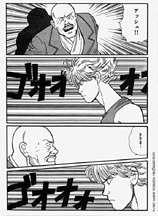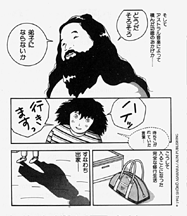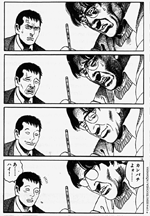Knowing a Nation in Comic Books
The 'manga' craze says volumes about modern Japanese culture
By Richard von Busack
JAPAN IS A NATION hooked on comic books. From Prime Minister Hashimoto to toddlers, everyone reads manga, telephone booksized comic books printed on recycled paper. One title, Shukan Shonen Jump--"the Godzilla of the Japanese publishing world," researcher Frederik L. Schodt calls it--sells more than 5 million copies a week. An American publisher of comics would die writhing in ecstasy for a fraction of the market share of Japanese comics.
San Francisco author Schodt--who wrote Manga! Manga! (1983), the most authoritative text in English on the phenomenon--returns with a fascinating study of how much has changed since then. Dreamland Japan: Writings on Modern Manga (Stone Bridge Press; $16.95) makes a strong case that these comic books offer the West "a Rosetta stone."
Writes Schodt: "It's no exaggeration to say that one cannot understand modern Japan today without having some understanding of the role that manga play in society." As startling as the popularity of manga might be to Americans, what's even more startling is the range of subjects. The magazines concern everything from sex to child-rearing, from pachinko to office work. More than a few manga strongly critique the suffocating conformity and business corruption of Japan, Inc.
Akira Narita's wild accounts of casual sex encounters through the Japanese equivalent of 900-numbers are considered less offensive than the work of Yoshinor Kobayashi, who has infuriated readers with his satires of everything from the imperial family to the AUM cult accused of releasing poison gas on the Tokyo subway. Kobayashi depicted the commoner-born crown princess lobbing hand grenades at protesters; his cartoons on AUM landed him on the cult's death list.
Manga, like American adult comics, faced their own round of censorship. A campaign was launched against them in the early '90s. It was short-lived, as such moral purges inevitably are; equally inevitably, it was spurred by the arrest of a child murderer who also happened to be a comics fan. Comics were seized, and special trash cans were erected bearing the warning "minai, yomanai, yomasana" (don't look at them, don't read them, don't let anyone read them). When the dust cleared, manga were back to their usual disreputable but popular state.
A minority of manga is fairly ripe by our standards, featuring distinctly underaged-looking girl heroines and kimono-ripping fantasies that admittedly are geared for and purchased by women. "If manga are a visualization of people's fantasies," Schodt writes, "then the women of Japan today have some of the richest and most disturbing sex fantasies on the planet."
The comics may be deplorable to some, but the popularity of these manga demonstrates that images of sex and violence have failed to turn Japan into a nation of slavering fiends. Schodt, while defending the right of people to print whatever they please, has to admit, "Most manga, as a pop-culture medium, have always been trash."
ACKNOWLEDGING the worst, Schodt also remembers the best in a fond chapter on Osamu Tezuka, Japan's "God of Comics," who was Disney, Charles Schulz and Will Eisner all in one to Japan. Schodt got to meet the man, who was a physician and a superb conversationalist, in addition to being his country's greatest animator. Schodt also discusses the charges and countercharges of plagiarism in the depressing similarities between Tezuka's Kimba the White Lion and Disney's The Lion King.
Schodt sees the matter primarily as a study of the difference between Japanese and American notions of conflict resolution. Japanese reluctance to start lawsuits extends to the tolerance of dojinshi, amateur self-publishers of fanzines that incorporate popular manga figures. Freedom of the press sometimes seems more possible in a land where there aren't so many underemployed copyright lawyers.
Schodt's book is a first-rate study of a culture Americans know poorly, if at all. His study also offers hints on how U.S. comics could be improved. First, keep them free of censorship to appeal to the largest amount of people and thus make their subject matter reflect not just kid stuff but art for adults. Second, manga is taken seriously in Japan because there isn't any question about the genre's descent from serious art (it was the renowned engraver Hokusai himself, Schodt writes, who coined the word manga). In the U.S., it's time that comics were also recognized as a legitimate art, with an at least occasionally glorious past and a potentially exciting future.
[ Metro | Metroactive Central | Archives ]
This page was designed and created by the Boulevards team.

Point, Counterpoint: A young hero confronts a Mafia boss in four typically dynamic panels from Akimi Yoshida's "Banana Fish."
After discussing some of the larger magazines, Schodt focuses on 24 of the best creators in short, incisive and witty essays. The cartoonists include Yuji Aoki, whose tales of white-collar loan sharking in gritty Osaka are, Schodt says, "an ideal introduction to the underbelly of Japan's vaunted economy."


Editor's License: In Seiki Tsuchida's "King of Editors," an artist gets some tips from his manager.
From the October 10-16, 1996 issue of Metro
Copyright © 1996 Metro Publishing, Inc.
![[Metroactive Books]](/books/gifs/books.gif)